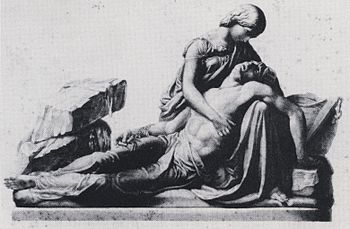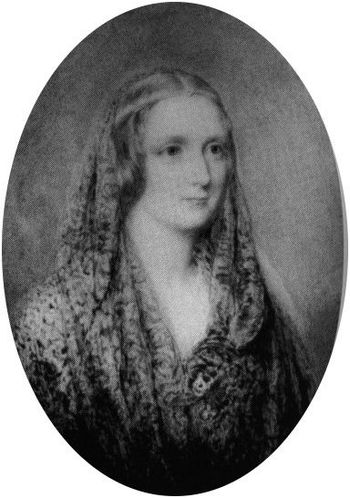 |
| Mary Wollstonecraft Shelley and Percy Bysshe Shelley. Stipple engraving. (Photo credit: Wikipedia) |
If you don't know already, my guess is that if I told you the above description was taken from another novel based on Mary Shelley's "Frankenstein" you would not challenge me. Besides his wild eyes, Mary Shelley offers us no physical descriptions of Victor Frankenstein in her novel. However, the above text comes from Shelley's biographer, Thomas Jefferson Hogg when he describes the famous poet during his time at Oxford University. It's an interesting image. Like Victor Frankenstein, Shelley combined an avid interest in the metaphysical and the occult with the ways of modern science. His spirit and manic enthusiasm paint the very picture many actors would take on board when they portrayed this character.
I have read Mary Shelley's most famous novel, "Frankenstein", a number of times now throughout my life. It first made its way into my life via the Universal monster movies that were The novel, the history of its origin and its legacy fascinate me. I don't think I am overstating the novel's status by calling it an enigma. The novel breaks with the conventions of the Gothic fiction of its day and is considered by many to be the first example of a science fiction novel. Since its first publication, the novel and its author have been thoroughly dissected by fascinated academics. She was apparently born during an electrical storm, the genus of the novel occurred during an electrical storm and Percy Shelley, her poet husband, was killed when his boat ran into a storm at sea.
 |
| Reginald Easton painted this miniature portrait of Mary Shelley, on a flax coloured background. It incorporates a circlet backed by blue, the same seen in the Rothwell painting and a shawl. Seymour, p543 Abinger Collection (Photo credit: Wikipedia) |
 |
| Cover of Percy Bysshe Shelley |
There is a parallel case with John Polidori's hugely influential novella, "The Vampye: A Tale" (which is contained as an appendix in the Penguin Classic edition). The work was attributed to Lord Byron and Polidori felt the need to write a short preface to a later edition of the work to state that this wasn't the case. Nevertheless, the character of Lord Ruthven is clearly based on Byron's scandalous image and one of his conquests seems to be have been inspired by his ex-lover-turned-stalker, Lady Caroline Lamb. Lamb had already written her own novel three years before Polidori with another character called Lord Ruthven, a rakish figure that was blatantly a unflattering fictionalization of Lord Byron.
The character of Victor Frankenstein is a sympathetic and human role, but he is also an example of the overreacher and his life resembles the legend of Faust. The meeting between Frankenstein and the explorer, Walton, that bookend the story make the strong argument against the perils of become obsessed with challenging nature. Despite the progressive radicals that surrounded and clearly impressed Mary (she dedicated the novel to her father), her tale is a cautionary one. Hindle quotes Mary eventually becoming a staunch moderate who warned against extremism in any direction. It might be concluded that she saw the dangers of radicalism around her and Shelley's own forceful attitude spoke to her fears. Polidori wrote "The Vampyre" after he had fallen out with Byron and he models the story's mortal opponent of Ruthven on himself. It might be argued that Victor Frankenstein is Mary's subtler and kinder critique of her electrifying husband...
Don't forget to check out Jamie Clubb's main blog www.jamieclubb.blogspot.com









